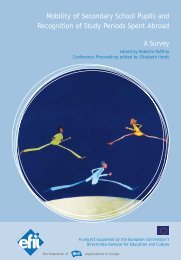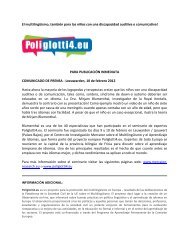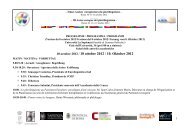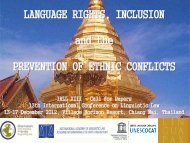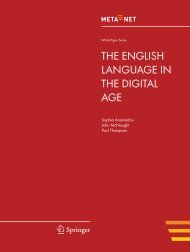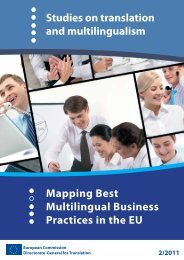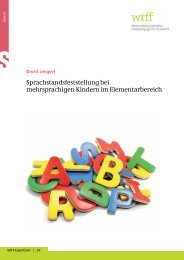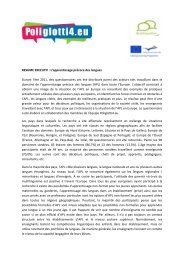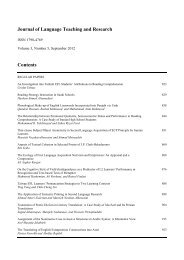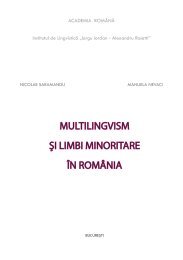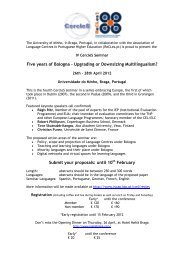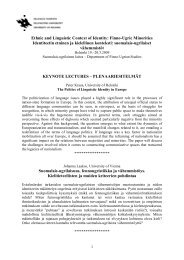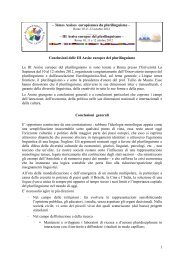FULL VERSION - European Commission - Europa
FULL VERSION - European Commission - Europa
FULL VERSION - European Commission - Europa
Create successful ePaper yourself
Turn your PDF publications into a flip-book with our unique Google optimized e-Paper software.
BEST PRACTICE EXAMPLE 3: Non formal learning in school education - SteinerWaldorf Education -Steiner Waldorf education (SWE) has been propagating multilingualism since the founding of the firstWaldorf School in Stuttgart in 1919. The school opened with English and French taught from class oneonwards. Since then, immersion in other languages using artistic methods such as simple plays,choral speaking and games have been very successful in supplementing standard ways of languagelearning well known in standard formal education.In certain places, the Steiner Waldorf impulse of artistic multilingualism has reached beyond theschool education setting into non-formal education (plays put on "after hours", offeringartistic language immersion in civic centres). 39 Steiner Waldorf education is present in 23 <strong>European</strong>countries, in about 700 schools.The importance of experiencing a living languageTraditional formal language teaching has developed a certain tenacity because it is obligatory. In nonobligatorynon formal and informal education, multilingualism can flower only when language isallowed to become alive and is also fun to participate in. Non formal education should be ‘leisure’ time.Traditional forms of cerebral language education unfortunately sometimes stand in the way oflanguage immersion. Cartoons and - often boring - "everyday usage" dialogues in modernday textbooks have not really solved this problem.Languages come alive in dialogue between people. The person facilitating the language should betrained in artistic methods well beyond cognitive language skills.SWE stresses the importance of the inner experience by a vivid perception.Living through a language connects with attitudes, conventions, values, thinking and a culturalheritage, as expressions of a specific culture.Imagination is evoked and all senses are activated to create a deep feeling for intuitive understandingof the inner message of the speaker. So language also becomes a means for creating an open mindand ‘linkedness’ towards other cultures and social environments.The importance of a very early immersionA very early start, with several foreign languages at the same time, is due to the characteristics of thisage:- the plasticity of the speech organs,- the strong faculty in young children for mimicking / imitation,- their open attitude towards strange phenomena,- and the joy of young children of learning as a matter of course. 40Especially for young children:• the atmosphere should be joyful, and related to the learned foreign language. It should help toimmerse the children in this other culture;• repetition is important, as well as to support the sounds by meaningful gestures;• this means that the gestures should be artistic, ‘beautiful’ but ‘exact‘ and joyful, andcorrespond with the content and the soul of a text, a poem, a song, a dialogue;- it should be playing with sonorities, and moving together;- they should experience a certain harmony between the sound and the meaning of a word.• the teachers’ attitude should be positive, relaxed, welcoming the children, listening and notjudging;• he should provide a clear structure (repetition, imitation, rhythm, moving together in patterns)that also helps concentration;39A best practice example can be found in the delivered text “Laying seeds for multilingualism in children outside of formaleducation: "Heure française" in a German civic centre”.40Cfr ‘Fremdsprachenunterricht auf der Primärstufe. Seine Begründung und Praxis in der Waldorfpädagogik, Christoph Jaffke,1996, Deutscher Studien Verlag, Weinheim.Civil Society Platform on Multilingualism 63APPENDIX to Policy Recommendations06/06/2011 – FINAL <strong>VERSION</strong>



